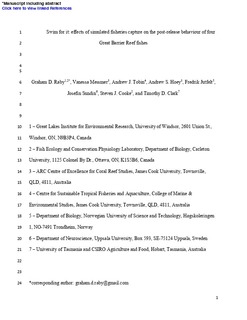Swim for it: Effects of simulated fisheries capture on the post-release behaviour of four Great Barrier Reef fishes
| dc.contributor.author | Raby, Graham | |
| dc.contributor.author | Messmer, Vanessa | |
| dc.contributor.author | Tobin, Andrew | |
| dc.contributor.author | Hoey, Andrew | |
| dc.contributor.author | Jutfelt, Fredrik | |
| dc.contributor.author | Sundin, Josefin | |
| dc.contributor.author | Cooke, Steven J. | |
| dc.contributor.author | Clark, Timothy | |
| dc.date.accessioned | 2019-04-29T12:30:02Z | |
| dc.date.available | 2019-04-29T12:30:02Z | |
| dc.date.created | 2018-05-29T09:16:15Z | |
| dc.date.issued | 2018 | |
| dc.identifier.issn | 0165-7836 | |
| dc.identifier.uri | http://hdl.handle.net/11250/2595966 | |
| dc.description.abstract | After being caught and released by a fishery, some animals may be sufficiently impaired so as to be vulnerable to predators. The duration and severity of post-release impairments have rarely been studied under natural conditions; the vitality of animals is usually assessed aboard a vessel, prior to release, while examinations of post-release behaviour are usually restricted to what is within view of a vessel. In this study, we quantified the post-release behavior of the common coral trout (Plectropomus leopardus), two species of emperor (Lethrinus spp.), and the Spanish flag snapper (Lutjanus carponotatus), each of which is actively fished throughout the Great Barrier Reef. SCUBA divers followed fish in the field and recorded their behavior with underwater video cameras after a simulated catch-and-release event. Relative to a low stress treatment (held in an aerated tank prior to release), fish exposed to forced exercise and 5 min of air exposure spent more time in vulnerable positions after release, including 5.8× more time immobile under the boat upon release, 1.6× more time to reach the reef floor, and 2.4× longer to reach the protection of the reef. The effects of the catch-and-release simulation on tailbeat frequency, ventilation rate, and the proportion of overall time spent immobile were not significant except in L. carponotatus, which spent significantly more time immobile when exposed to the high stress treatment. Indeed, there were some notable differences among species, with the magnitude of the behavioural impairments being lower and less variable in coral trout than in Lethrinus spp. or L. carponotatus. These findings provide support for the notion that minimizing air exposure time in hook-and-line fisheries should reduce post-release behavioural impairments and thus vulnerability to predators. | nb_NO |
| dc.language.iso | eng | nb_NO |
| dc.publisher | Elsevier | nb_NO |
| dc.rights | Attribution-NonCommercial-NoDerivatives 4.0 Internasjonal | * |
| dc.rights.uri | http://creativecommons.org/licenses/by-nc-nd/4.0/deed.no | * |
| dc.title | Swim for it: Effects of simulated fisheries capture on the post-release behaviour of four Great Barrier Reef fishes | nb_NO |
| dc.title.alternative | Swim for it: Effects of simulated fisheries capture on the post-release behaviour of four Great Barrier Reef fishes | nb_NO |
| dc.type | Journal article | nb_NO |
| dc.type | Peer reviewed | nb_NO |
| dc.description.version | acceptedVersion | nb_NO |
| dc.source.volume | 206 | nb_NO |
| dc.source.journal | Fisheries Research | nb_NO |
| dc.identifier.doi | 10.1016/j.fishres.2018.05.012 | |
| dc.identifier.cristin | 1587307 | |
| dc.description.localcode | © 2018. This is the authors’ accepted and refereed manuscript to the article. Locked until 24.5.2020 due to copyright restrictions. This manuscript version is made available under the CC-BY-NC-ND 4.0 license http://creativecommons.org/licenses/by-nc-nd/4.0/ | nb_NO |
| cristin.unitcode | 194,66,10,0 | |
| cristin.unitname | Institutt for biologi | |
| cristin.ispublished | true | |
| cristin.fulltext | original | |
| cristin.qualitycode | 1 |
Tilhørende fil(er)
Denne innførselen finnes i følgende samling(er)
-
Institutt for biologi [2512]
-
Publikasjoner fra CRIStin - NTNU [37177]

